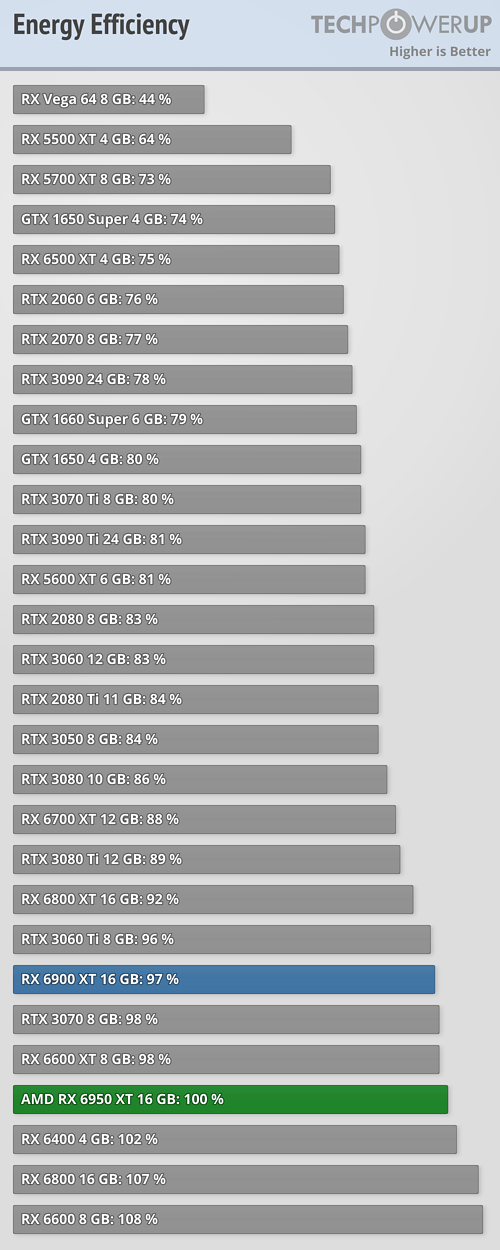 36
36
AMD Radeon RX 6950 XT Reference Design Review
Overclocking »Performance per Watt
Performance per watt is based on measurements using Cyberpunk 2077. We record power draw and FPS rate to calculate the energy efficiency of the graphics card as it operates.
Voltage Frequency Curve
The card will dynamically adjust clock and voltage based on render load, temperature, and other factors.For the graph below, we recorded all GPU clock and GPU voltage combinations of our 1440p resolution benchmarking suite. The plotted points are transparent, which allows them to add up to indicate more often used values. A light color means the clock and voltage combination is rarely used, and a dark color means it's active more often. The minimum and maximum values are 99th and 1st percentile, so outliers are excluded.

Clock States
| Clock Frequencies & Voltage | |||
|---|---|---|---|
| GPU Clock | Memory Clock | GPU Voltage | |
| Idle | 0 MHz 0 to 3 MHz | 7 MHz 2 to 150 MHz | 0.014 V 0.000 to 0.825 V |
| Multi-Monitor | 0 MHz 0 to 8 MHz | 2238 MHz 2224 to 2242 MHz | 0.069 V 0.000 to 0.825 V |
| Video Playback | 7 MHz 4 to 16 MHz | 2237 MHz 2224 to 2242 MHz | 0.828 V 0.825 to 0.850 V |
| Furmark | 2046 MHz 2025 to 2079 MHz | 2238 MHz 2236 to 2240 MHz | 0.900 V 0.887 to 0.912 V |
| Gaming (Cyberpunk 2077) | 2311 MHz 2298 to 2320 MHz | 2238 MHz 2236 to 2240 MHz | 1.025 V 0.856 to 1.050 V |
| V-Sync (Cyberpunk 2077) | 1088 MHz 331 to 1591 MHz | 2236 MHz 2222 to 2244 MHz | 0.937 V 0.825 to 1.200 V |
| Gaming (23 Games) | 2404 MHz 1855 to 2680 MHz | 2250 MHz | 1.118 V 0.937 to 1.200 V |
Jul 3rd, 2025 21:38 CDT
change timezone
Latest GPU Drivers
New Forum Posts
- How do you view TPU & the internet in general? (With poll) (58)
- HP Zbook 15 G2 GPU Upgrade (12)
- What Windows is overall the best to you and why? (266)
- Will you buy a RTX 5090? (610)
- What phone you use as your daily driver? And, a discussion of them. (1756)
- GPU-Z Display Bug via DP 2.1? (3)
- What would you buy? (51)
- A Final Fantasy IX Reminiscence - My love letter and homage to one of the best stories ever told (90)
- GravityMark v1.89 GPU Benchmark (309)
- RTX 5070 discussion (5)
Popular Reviews
- ASUS ROG Crosshair X870E Extreme Review
- Crucial T710 2 TB Review - Record-Breaking Gen 5
- Fractal Design Scape Review - Debut Done Right
- PowerColor ALPHYN AM10 Review
- Sapphire Radeon RX 9060 XT Pulse OC 16 GB Review - An Excellent Choice
- Upcoming Hardware Launches 2025 (Updated May 2025)
- AMD Ryzen 7 9800X3D Review - The Best Gaming Processor
- Sapphire Radeon RX 9070 XT Nitro+ Review - Beating NVIDIA
- SCHENKER KEY 18 Pro (E25) Review - Top-Tier Contender
- AVerMedia CamStream 4K Review
TPU on YouTube
Controversial News Posts
- Intel's Core Ultra 7 265K and 265KF CPUs Dip Below $250 (288)
- NVIDIA Grabs Market Share, AMD Loses Ground, and Intel Disappears in Latest dGPU Update (212)
- Some Intel Nova Lake CPUs Rumored to Challenge AMD's 3D V-Cache in Desktop Gaming (140)
- NVIDIA GeForce RTX 5080 SUPER Could Feature 24 GB Memory, Increased Power Limits (115)
- Microsoft Partners with AMD for Next-gen Xbox Hardware (105)
- NVIDIA Launches GeForce RTX 5050 for Desktops and Laptops, Starts at $249 (105)
- Intel "Nova Lake‑S" Series: Seven SKUs, Up to 52 Cores and 150 W TDP (100)
- NVIDIA DLSS Transformer Cuts VRAM Usage by 20% (97)